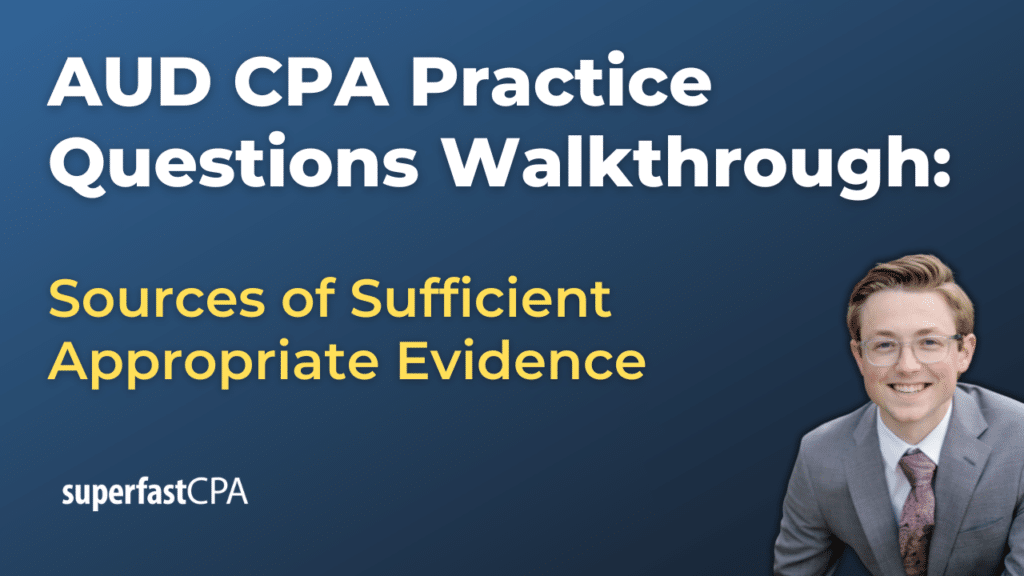In this video, we walk through 5 AUD practice questions teaching about sources of sufficient appropriate evidence. These questions are from AUD content area 3 on the AICPA CPA exam blueprints: Performing Further Procedures and Obtaining Evidence
The best way to use this video is to pause each time we get to a new question in the video, and then make your own attempt at the question before watching us go through it.
Also be sure to watch one of our free webinars on the 6 “key ingredients” to an extremely effective & efficient CPA study process here…
Sources of Sufficient Appropriate Evidence
One of the fundamental responsibilities of an auditor is to obtain sufficient appropriate evidence to support their opinion on the financial statements. The strength of an auditor’s conclusion depends on both the quantity (sufficiency) and quality (appropriateness) of the evidence collected. Without strong audit evidence, an auditor cannot provide reasonable assurance that the financial statements are free from material misstatement. This article covers key concepts related to audit evidence, including the importance of persuasive and reliable evidence, the hierarchy of reliability, and how internal controls impact the strength of evidence.
Evidence Must Be Persuasive and Reliable
Audit evidence should be persuasive rather than conclusive. Auditors are not expected to prove absolute accuracy but must gather enough reliable information to form a reasonable basis for their opinion. The goal is to reduce audit risk to an acceptably low level while maintaining efficiency in the audit process.
For example, an auditor reviewing accounts receivable might obtain customer confirmations to verify balances rather than relying on an internal email between employees discussing collections. A direct confirmation from a customer provides stronger evidence than management’s representations about receivables. Similarly, when auditing revenue recognition, an auditor may review executed contracts and third-party shipping documents rather than accepting an internal report from the sales department at face value.
External Evidence Is the Most Reliable
Evidence obtained directly from an independent external source is considered the strongest form of audit evidence. This includes bank confirmations, supplier invoices, and legal letters received directly by the auditor. The reason external evidence is so reliable is that it comes from a party who is not biased toward the client’s financial reporting outcomes.
For instance, if an auditor needs to verify cash balances, a bank confirmation received directly from the financial institution is more reliable than a bank statement printed by the client. Similarly, obtaining a confirmation of outstanding balances from vendors provides stronger evidence than a reconciliation report prepared by the client’s accounting team. The independence of the source significantly enhances the reliability of the evidence.
Not All Internal Evidence Carries the Same Weight
Internally generated evidence, such as financial reports and management representations, is inherently less reliable because it comes from within the entity being audited. However, not all internal evidence is of equal weight. If an internal document is backed by external evidence—such as an internally prepared depreciation schedule supported by third-party purchase invoices—its reliability increases.
For example, internally generated payroll reports can be useful, but they are more persuasive when tied to external evidence like payroll tax filings or independent third-party payroll processing records. Auditors must assess whether internal evidence is supported by robust internal controls or if additional corroboration is needed from external sources.
Direct Auditor Observation Has Value but Limitations
When an auditor personally inspects assets or observes processes, this evidence is considered more reliable than internal documents. Direct observation helps verify existence but may not always establish ownership, rights, or valuation.
For example, an auditor inspecting an inventory warehouse can confirm the presence of goods but still needs purchase records or supplier confirmations to verify ownership. Similarly, attending a client’s physical inventory count can confirm that procedures are being followed but does not necessarily confirm the completeness or valuation of inventory.
Direct observation is useful but should be supplemented with additional documentation to strengthen the evidence collected.
Internal Controls Affect the Reliability of Evidence
The strength of a company’s internal controls directly impacts the reliability of internal audit evidence. When controls are strong—such as well-documented approvals, restricted access to financial records, and proper segregation of duties—internally generated reports become more trustworthy. Conversely, weak controls increase the risk of misstatement, requiring the auditor to seek additional external corroboration.
For instance, if an organization has a history of weak controls over revenue recognition, an auditor would place less reliance on its internally generated sales reports and instead obtain customer confirmations or contract reviews. Similarly, if a company lacks controls over journal entries, the auditor may need to perform more detailed testing of individual transactions rather than relying on summary-level reports.
Conclusion
Obtaining sufficient appropriate evidence is at the core of an auditor’s responsibilities. While external evidence is generally the most reliable, auditors must assess the context in which all evidence is gathered. Understanding the impact of internal controls and the hierarchy of reliability helps auditors form well-supported opinions and enhance the credibility of financial reporting.
In every audit, professional judgment is required to evaluate the sufficiency and appropriateness of evidence. Auditors must consider the source, reliability, and relevance of each piece of evidence to ensure they are forming conclusions based on strong, persuasive information rather than weak or easily manipulated data. A well-executed audit relies on a strategic approach to gathering evidence, balancing efficiency with the need for high-quality assurance.














